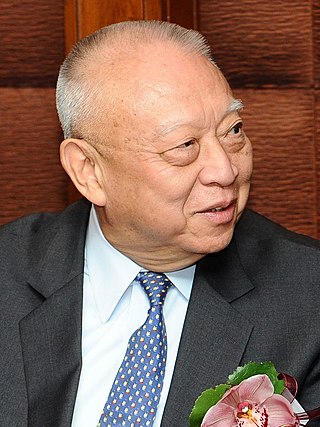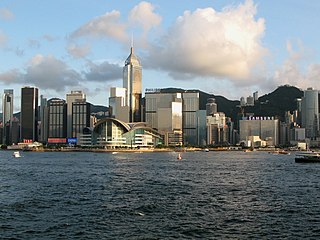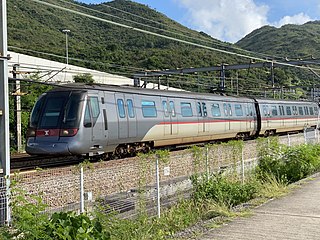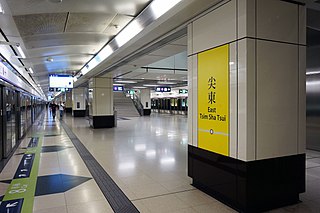This article needs to be updated.(August 2010) |
| This article is part of a series on the |
| History of Hong Kong |
|---|
 |
| Timeline |
|
| By topic |
The 2000s in Hong Kong began a new millennium under the People's Republic of China (PRC).
This article needs to be updated.(August 2010) |
| This article is part of a series on the |
| History of Hong Kong |
|---|
 |
| Timeline |
|
| By topic |
The 2000s in Hong Kong began a new millennium under the People's Republic of China (PRC).

After the transfer of sovereignty, Hong Kong faced a series of problems, both political and economical. The government carried out a series of reforms to adopt a more modern ideology and democracy, but faced many difficulties. Despite a transfer of power to China, the citizens participate in how their government is run, and the region maintains some degree of autonomy. Media in Hong Kong has not come under state control, though many citizens believe the media practices self-censorship. The economy would also begin the period with a rise in unemployment rate from 2.2% in 1997 to 4.4% in 2000, and 7.9% in 2003. The economy had gradually recovered since 2004 and the overall unemployment rate fell to 3.6% in 2008, however the overall figure rose again to 5.4% in 2009 due to the global economic downturn in the last quarter of 2008. [1]
The two major political camps of the decade are the Pro-Beijing camp and the Pro-democracy camp.
In 2003, the government proposed an anti-subversion law titled Article 23 of the Hong Kong Basic Law. Many people feared that the proposal would erode freedom of press, religion, and association. The unpopularity of Chief Executive Tung Chee-Hwa and his administration, combined with the dissatisfaction about economy recession and the pandemic control, prompted an estimated 500,000 - 1,000,000 people to march on 1 July 2003, making it the largest since the Tiananmen Square protests of 1989. [2] [3] The proposal fell after the several pro-government lawmakers withdrew their support to pass the bill. The resignation of Liberal Party chief James Tien from the Executive Council on 6 July 2003 caused the eventual withdrawal of the legislation and the break-up of the "ruling alliance" of the Chief Executive. The security secretary, Regina Ip, who was heavily criticised for her arrogant and condescending handling of the proposed law, was forced to resign. [4]
For the first time in Hong Kong's history, on 1 July 2006, the People's Liberation Army marched through the city. The display was one of power and symbolism staged by 19 pro-Beijing groups. The march was part of a celebration demonstration that began in Victoria Park. [5]
Many calls were made for the resignation of Tung Chee-hwa, a leader who was blessed by the Chinese Communist Party, Jiang Zemin. Tung remained in the office until 10 March 2005, 20 months after the march against Article 23. Hong Kong's Basic Law permitted Tung to serve another 3 years, many[ who? ] suspected Beijing forced him to resign due to widespread public disapproval and his perceived lacklustre leadership. The 2005 election filled the seat with Donald Tsang who was the No. 2 ranking official, Chief Secretary, and career civil servant during British colonial rule.
A survey conducted by the Hong Kong Journalists Association found that 58.4% of journalists think press freedom in HK has deteriorated since the handover, mainly as a result of self-censorship and government's tighter grip on information flow. [6] Direct Internet censorship in Hong Kong has not been a major issue. In 2009 HK was still ranked 48 by the international Press Freedom Index. [7] This is still far ahead of the People's Republic of China. Other self-censorship events include the 2009 Hong Kong Broadcasting Authority forum where major station TVB was labeled as CCTVB with censored news like the mainland's CCTV. [8] The local Citizens' Radio was raided by the Office of the Telecommunications Authority (OFTA) after being deemed illegal. [9]
The 1997 Asian Financial Crisis caused a deflationary period that spanned 6 years into July 2004. [10] A few years later, the global Financial crisis of 2007–2010 rocked the financial well-being of the SAR's financial sector. The Lehman mini-bond crisis was one that affected the territory greatly. Joseph Yam, the Chief Executive of the Hong Kong Monetary Authority who was the highest paid central banker in the world resigned in 2009. [11] [12] Traditionally, HK dollar is pegged against the US dollar. Questions have come up on whether HK should peg to the Chinese yuan since it is integrated to China economically. But since the yuan is not fully convertible, a peg to the yuan would cause disruptions. [13]
At the end of the 2000s, the International Commerce Centre (ICC), at 484 m (1,588 ft) high, was the tallest building in Hong Kong. The tallest building prior to the ICC was the Two International Finance Centre (2 IFC), at 415 m (1,362 ft) high, completed in 2003. Prior to that, the tallest building in Hong Kong was the Central Plaza since 1992, with a height of 374 m (1,227 ft).
Many new infrastructure projects had been completed throughout the territory during the 2000s. Examples of those infrastructures includes: For Railway - the completion of MTR Tseung Kwan O line in 2002, KCR West Rail in 2003, KCR Ma On Shan Rail in 2004, MTR Disneyland Resort line in 2005, the extension of the Airport Express to AsiaWorld–Expo in 2005, KCR Lok Ma Chau Spur Line in 2007, and MTR Kowloon Southern Link between East Rail line and West Rail line from Hung Hom station to Nam Cheong station via East Tsim Sha Tsui station and Austin station in 2009. For major bridges and tunnels - the completion of Discovery Bay Tunnel in 2000, Nam Wan Tunnel in 2007, Deep Bay Bridge (Hong Kong–Shenzhen Western Corridor) in 2007, Eagle's Nest Tunnel and Sha Tin Heights Tunnel in 2008, and Stonecutters Bridge in 2009.
Other major infrastructures includes the opening of the Hong Kong Disneyland in 2005, which was the fifth Disneyland opened in the world and the second opened in Asia after the Tokyo Disneyland, and the completion of the Ngong Ping 360 in 2006, which was a gondola lift system that connects Tung Chung New Town and Ngong Ping Market.
In 2000, the population of Hong Kong was 6,900,000. [14] The population in the summer of 2006 was 6,994,500, though the majority of population increase is mostly contributed via immigration from mainland citizens. Also in 2006, the birth rate of 7.29 is ranked lowest among the list of countries surveyed by the CIA. [15] Towards the end of the decade, Hong Kong's population had slowed further to a growth of 0.5% in 2009 with the city having a total population of 7,055,071 as of 2009. [16] Other new immigration topics include the Right of abode issue, Quality Migrant Admission Scheme or the Capital Investment Entrant Scheme. [17]

The passing of idol legends like Leslie Cheung and Anita Mui rocked the cantopop industry. Their deaths in the early 2000s further sank the people's morale. The 2008 Edison Chen photo scandal was also dubbed Asia's biggest scandal. [18] Other cultural phenomenon include the rise of young female Liang mou models.
The HK government and entertainment industry pursued a number of major charities in the decade. The 1:99 Concert was held for the SARS outbreak. In early 2005, a major relief campaign concert was held for the victims of the neighbouring 2004 Indian Ocean Tsunami. [19] [20] This was followed by one of the largest assembly of celebrities in the territory in the Artistes 512 Fund Raising Campaign for the 2008 Sichuan earthquake. In 2009 the Artistes 512 Fund Raising Campaign was held for Typhoon Morakot in Taiwan.
Hong Kong was the site for the 2008 Olympics and paralympics Equestrian events. The events were held at the Hong Kong Sports Institute in Fo Tan, Sha Tin. The torch relay also passed through both the Special administrative regions of HK and Macau. Various stars and celebrities were also present at the opening ceremonies in Beijing. At the end of 2009, HK also held its first ever East Asian Games. It opened up with a performance on the water of Victoria Harbour. [21]
Beginning in 2008, the Mong Kok acid attacks began a series of acid throwing incidents from tall buildings. The government also stepped up effort against many incidents of throwing any random objects out of skyscraper windows and roofs. The housing department began installing closed-circuit television systems to monitor these throwing activities. [22] Other incident involve the creation of a mass-suicide Facebook group called "I want to practise suicide" (我要(練習)自殺). The group was shut down before urging 190 members to kill themselves. [23] [24]

Health officials made the Bird Flu crisis a top priority beginning in 1997. To control the spread of the virus, millions of chickens were slaughtered in an extreme measure to prevent the global spread of the H5N1 virus. The crisis would lead to a series of panic that continue well into the 2000s. The volume consumption of poultry was significantly reduced for a period. Beginning in 1997, over 1 million birds were slaughtered, followed by 860,000 in 2002. Another batch of 300,000 and 200,000 chickens in 5 farms in Kam Tin New Territories were also included in the quarantine process. [25]
China also had series of outbreaks, and the pandemic have left both regions strained in trade relationships. [26] Controversies of the handling of the crisis has been criticised by radio programmes, TVs and newspapers. Both Hong Kong and China were the center of international attention during the early 2000s. Specifically, the Health, Welfare and Food Bureau were constantly bombarded with questions about the effectiveness in the decision to slaughter in large numbers. Wild dogs, rats and cats preying on bags of uncollected dead poultry also made the whole procedure a public relations disaster for the government. [27] In 2009 a Swine flu pandemics followed, but citizens were more prepared this time.
The first suspected case of severe acute respiratory syndrome (SARS) was recorded in February, 2003. Hong Kong remained on the World Health Organization's list of affected areas until 23 June 2003. The city was gripped by fear of contagion and panic throughout the epidemic. Children stayed home, while schools were halted. Economic activities were greatly disrupted. Restaurants were empty, and tourism ground to a halt. The epidemic infected more than 1,700 people and claimed 299 lives. [28] As director general of the World Health Organization, Margaret Chan faced some tough issues.

The World Trade Organization Conference of 2005 was held in Wan Chai. With 148 nations participating at the Hong Kong Convention and Exhibition Centre, it was one of the largest international event ever held in the area. A series of protests broke out in the designated protest zones and Hong Kong Police were resorted to using tear gas and pepper spray for crowd control. Numerous sources proclaimed the conference as the "Siege of Wan Chai" as the world class city became the hosting site of the event. [29]

Hong Kong has a highly developed transport network, encompassing both public and private transport. Based on Hong Kong Government's Travel Characteristics Survey, over 90% of daily journeys are on public transport, the highest rate in the world. However, in 2014 the Transport Advisory Committee, which advises the Government on transportation issues, issued a report on the much-worsened congestion problem in Hong Kong and pointed at the excessive growth of private cars during the past 10–15 years.

Tung Chee-hwa is a Hong Kong businessman and retired politician who served as the first Chief Executive of Hong Kong between 1997 and 2005, upon the transfer of sovereignty on 1 July. He served as a vice chairman of the Chinese People's Political Consultative Conference (CPPCC) between 2005 and 2023.

Wan Chai is situated at the western part of Wan Chai District on the northern shore of Hong Kong Island, in Hong Kong. Its other boundaries are Canal Road to the east, Arsenal Street to the west and Bowen Road to the south. The area north of Gloucester Road is often referred to as Wan Chai North.

The Mass Transit Railway (MTR) is a major public transport network serving Hong Kong. Operated by the MTR Corporation (MTRCL), it consists of heavy rail, light rail, and feeder bus services, centred around a 10-line rapid transit network, serving the urbanised areas of Hong Kong Island, Kowloon, and the New Territories. The system encompasses 245.3 km (152.4 mi) of railways, as of December 2022, with 179 stations—including 99 heavy rail stations, 68 light rail stops and 1 high-speed rail terminus.

The Kowloon–Canton Railway was a railway network in Hong Kong. It was owned and operated by the Kowloon–Canton Railway Corporation (KCRC) until 2007. Rapid transit services, a light rail system, feeder bus routes within Hong Kong, and intercity passenger and freight train services to China on the KCR network, have been operated by the MTR Corporation since 2007.

Sir Donald Tsang Yam-kuen is a former Hong Kong civil servant who served as the second Chief Executive of Hong Kong from 2005 to 2012.

Hong Kong Disneyland is a theme park located on reclaimed land in Penny's Bay, Lantau Island, Hong Kong. It was the first Disneyland in Asia outside of Japan until Shanghai Disneyland in 2016. Hong Kong Disneyland is located inside the Hong Kong Disneyland Resort and is owned and managed by Hong Kong International Theme Parks. It is the most visited theme park in Hong Kong, followed by Ocean Park Hong Kong. Hong Kong Disneyland opened to visitors on Monday, September 12, 2005, at 13:00 HKT. Disney attempted to avoid problems of cultural backlash by incorporating Chinese culture, customs, and traditions when designing and building the resort, including adherence to the rules of feng shui. Notably, a bend was put in a walkway near the Hong Kong Disneyland Resort entrance so good qi energy would not flow into the South China Sea.

The Tung Chung line is one of the ten lines of the MTR system in Hong Kong, linking the town of Tung Chung with central Hong Kong. It was built in the 1990s as part of the Airport Railway project, part of the construction of the new Chek Lap Kok Airport. The line currently travels through eight stations in 31 minutes along its route. The line is coloured orange on the MTR system map.

Citybus Limited is a bus company which provides both franchised and non-franchised service in Hong Kong. The franchised route network serves Hong Kong Island, cross-harbour routes, North Lantau, Hong Kong International Airport, Kowloon, New Territories, Shenzhen Bay Port and Hong Kong–Zhuhai–Macau Bridge Hong Kong Port. The non-franchised routes serve mainly City One Sha Tin. It also provides bus rental services and staff bus services for some large companies, such as TVB and China Light and Power.

East Tsim Sha Tsui is a station of the Mass Transit Railway (MTR) system of Hong Kong. It is currently an intermediate station on the Tuen Ma line.

The Hong Kong Disneyland Resort is a resort built and owned by Hong Kong International Theme Parks Limited, a joint venture of the Government of Hong Kong and The Walt Disney Company in Hong Kong on reclaimed land beside Penny's Bay, at the northeastern tip of Lantau Island, approximately two kilometres (1.2 mi) from Discovery Bay. It is the second Disney Resort in Asia and the first Disney Resort in China. Officially opened on 12 September 2005, the resort contains the Hong Kong Disneyland theme park, the Hong Kong Disneyland Hotel, Disney's Hollywood Hotel, Disney Explorers Lodge and several retail, dining and entertainment facilities covering 1.3 square kilometres of the island.

The Airport Core Programme was a series of infrastructure projects centred on the new Hong Kong International Airport during the early 1990s. The programme was part of the Port and Airport Development Strategy, commonly known as the Rose Garden Project.

Tuen Mun Ferry Pier (屯門碼頭), or Tuen Mun Ferry Terminal, is a public pier located in the southern area of Tuen Mun, Hong Kong.

Kwu Tung is a planned underground infill station on the Lok Ma Chau spur line of the East Rail line of the MTR rapid transit network in Hong Kong. The station will be situated near Kwu Tung in North District, New Territories.

Margaret Chan Fung Fu-chun, is a Chinese-Canadian physician, who served as the Director-General of the World Health Organization (WHO) delegating the People's Republic of China from 2006 to 2017. Chan previously served as Director of Health in the Hong Kong Government (1994–2003) and representative of the WHO Director-General for Pandemic Influenza and WHO Assistant Director-General for Communicable Diseases (2003–2006). In 2014, Forbes ranked her as the 30th most powerful woman in the world. In early 2018 she joined the Chinese People's Political Consultative Conference (CPPCC).

Guangzhou–Shenzhen–Hong Kong Express Rail Link (XRL), also known as the Guangshengang XRL, is a high-speed railway line that connects Beijing and Hong Kong (Kowloon) via Guangzhou and Shenzhen.

Hong Kong's rail network mainly comprises public transport trains operated by the MTR Corporation Limited (MTRC). The MTRC operates the metro network of the territory, the commuter rail network connecting the northeastern, northwestern and southwestern New Territories to the urban areas, and a light rail network in northwestern New Territories. The operations of the territory's two leading railway companies, MTRC and the Kowloon-Canton Railway Corporation (KCRC), were merged in 2007 on grounds of economies of scale and cost effectiveness. The Hong Kong Government has an explicit stated transport policy of using railways as its transport backbone.

The Hong Kong government started developing new towns in the 1950s to accommodate Hong Kong's booming population. During the first phase of development, the newly developed towns were called "satellite towns", a concept borrowed from the United Kingdom, of which Hong Kong was a colony. Kwun Tong, located in eastern Kowloon, and Tsuen Wan, located in the south-west of the New Territories, were designated as the first satellite towns, when the urban area in Hong Kong was still relatively small, restricted to the central and western parts of Kowloon Peninsula and the northern side of Hong Kong Island. Wah Fu Estate was also built in a remote corner on the southern side of Hong Kong Island, with similar concepts but at a smaller scale.